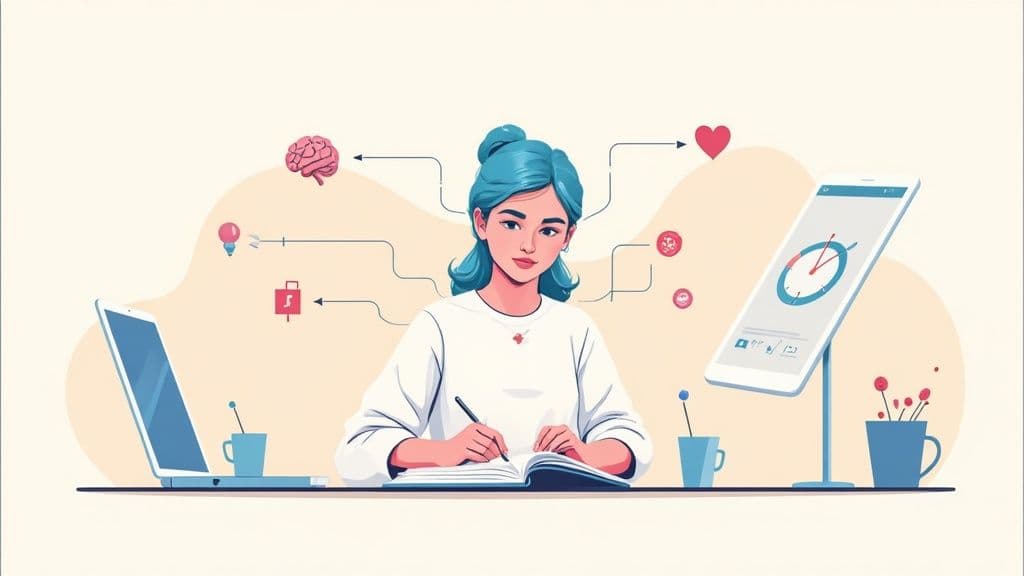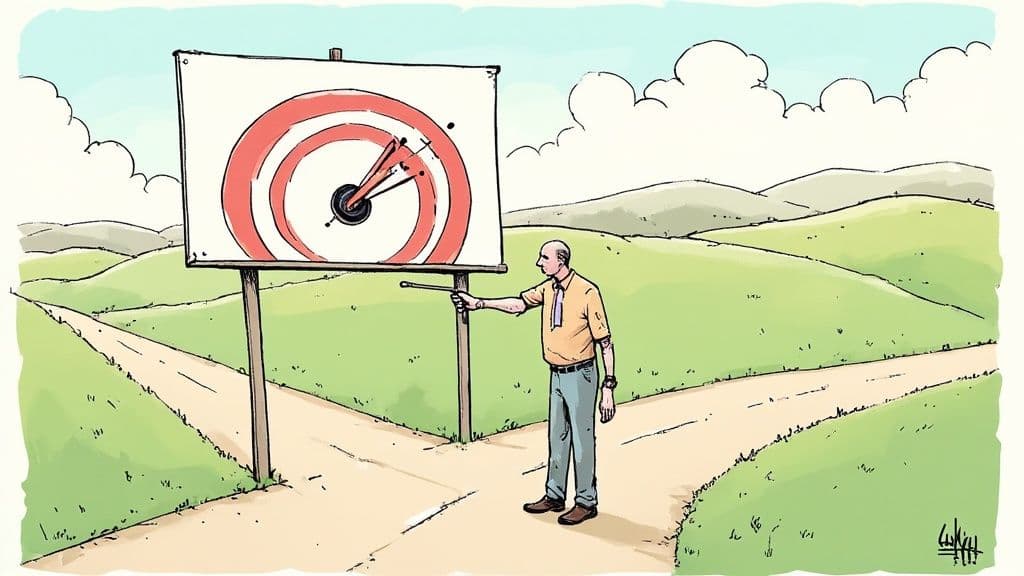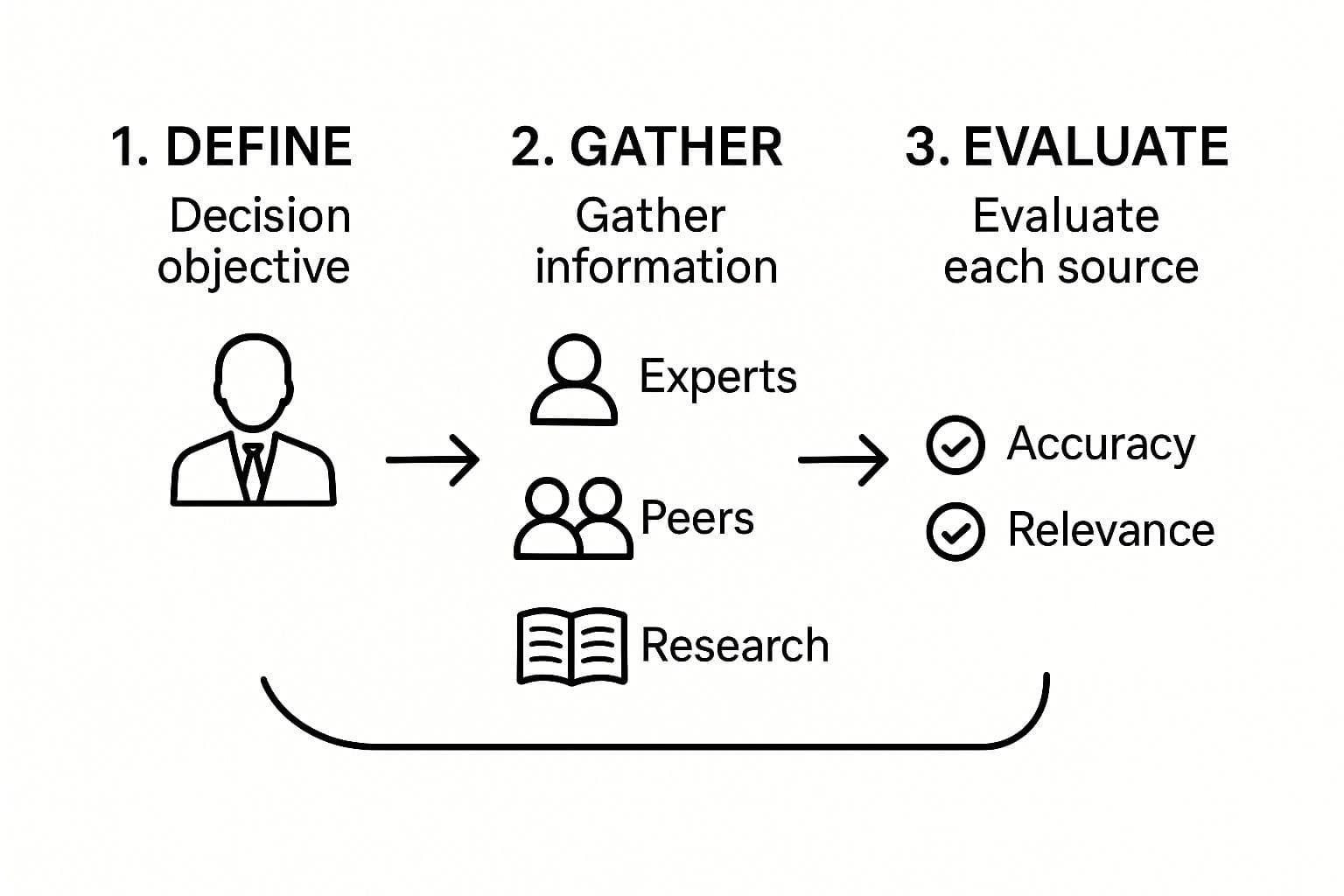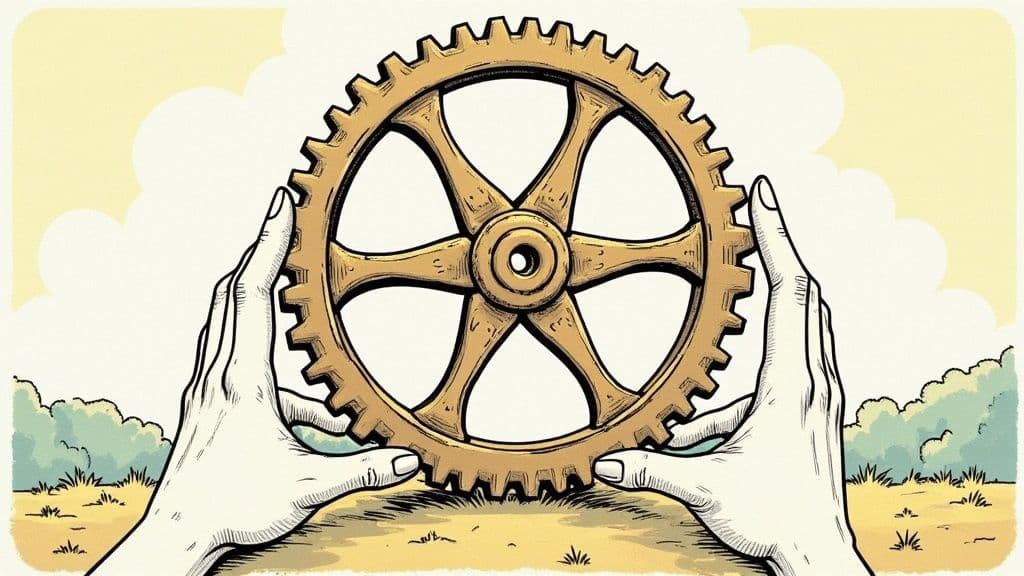Feeling stuck? Learn a practical framework that helps you separate emotional noise from the real question so you can make clearer, more confident choices.
September 18, 2025 (2mo ago) — last updated October 28, 2025 (1mo ago)
How to Make Better Decisions
Learn a practical framework to make clearer, less stressful decisions by balancing data, intuition, and small tests for real-world feedback.
← Back to blog
How to Make Better Decisions
Feeling stuck? Learn how to make clearer, less stressful decisions with a practical framework that blends data, intuition, and small-scale tests.
Making better decisions really comes down to one thing: separating the emotional noise from the actual problem. It’s not about hunting for some perfect answer. It’s about building a clear-headed, compassionate process to work through the choices in front of you.
Why big decisions feel paralyzing
Making a big decision can feel absolutely paralyzing. The real wrestling match happens in the messy space between logic and emotion, where fear of getting it wrong collides with pressure about what others think.

That endless loop of “what ifs” has a name: analysis paralysis. It’s the sense of being so overwhelmed by options and information that you end up doing nothing. Modern life fuels it—with more choices and more noise, our brains struggle to keep up.
The goal isn’t to erase uncertainty but to learn how to manage it in healthier, more productive ways.
Why modern life makes choices harder
Our brains weren’t built for a constant firehose of information. That overload leads to mental traps like confirmation bias, where we subconsciously seek evidence that supports what we already think and ignore anything that challenges it.
“The challenge isn’t just about making a choice; it’s about making a choice that feels right for you, despite external noise and internal fears.”
This pressure is especially acute around careers. The global workforce is shifting rapidly—about 22% of jobs will be significantly transformed by 20301. At the same time, many business leaders say better access to data has helped their decision-making, showing how vital clear thinking has become2.
A personal decision toolkit helps you:
- Normalize the struggle: Acknowledge that feeling stuck is normal.
- Spot mental traps: Recognize patterns like overthinking and confirmation bias.
- Create a clear path forward: Use a compassionate, practical process to move ahead.
A practical framework for clearer choices
Forget rigid formulas. What you need is a flexible framework you can apply to anything—from career pivots to personal dilemmas. Break what feels overwhelming into manageable steps, starting with getting honest about your real objective.
What’s the real “why” driving this decision? Are you moving toward something you want, or running away from something you don’t? Getting that North Star in focus helps when details get fuzzy.
Gather the right information—without drowning in it
Once you know your aim, gather targeted intelligence. This isn’t hoarding data; it’s strategic research. Problem-solving skills help you decide what to look for and what to ignore. See our Problem-Solving Guide for practical steps(/blog/how-to-improve-problem-solving-skills).
Organize research into three sources:
- Expert input: Talk with someone who’s been where you want to go.
- Peer feedback: Ask friends or colleagues who know you well.
- Objective research: Look at facts, trends, and numbers.

Filter everything through your core objective so you don’t get buried in irrelevant details.
Four phases that keep decisions manageable
| Phase | Core action | Mindset |
|---|---|---|
| Phase 1: Define | Clarify the problem and desired outcome. | Curiosity: “What am I really trying to achieve?” |
| Phase 2: Explore | Gather diverse information and generate options. | Openness: “What possibilities haven’t I considered?” |
| Phase 3: Evaluate | Assess options against your core objective. | Objectivity: “Which choice aligns with my values?” |
| Phase 4: Test | Run a small experiment before committing. | Pragmatism: “How can I try this with minimal risk?” |
These phases keep you structured but flexible so you avoid jumping to conclusions before doing the work.
Generate and test options
Now brainstorm—don’t censor yourself at first. Go beyond the obvious ideas. Many organizations settle for easy choices instead of the best ones; only a minority of executives rate their companies’ strategic decisions as high quality, which suggests we often default to convenience over rigor3.
Before making an irreversible move, run a low-stakes pilot test. If you’re considering a career change, try an online course, take on a freelance project, or volunteer a few hours a week. Small experiments provide real-world feedback and reduce risk.
Balance logic with your gut feeling
Data matters, but it rarely tells the whole story. Intuition—your gut feeling—is another important input, and the best decisions usually feel right both intellectually and instinctively.
How to tune into your inner voice
First, quiet external noise so you can hear what your intuition is saying. Distinguish that steady inner voice from louder impostors like raw fear or wishful thinking.
- Practice stillness. Try a five-minute quiet walk or a short phone-free break.
- Journal your feelings. Note how each option feels, not just the pros and cons.
- Notice physical cues. Your body often signals preference before your mind does.
Many leaders still rely on intuition—nearly half of C-suite executives report using intuition in decisions—while also questioning the accuracy of their data, highlighting the continued role of human judgment4.
If you want to strengthen intuition, try short exercises like free-writing your first impressions or using guided prompts. More exercises are in our Self-Discovery Prompts(/blog/self-discovery-journal-prompts).
Using life-path insight for deeper alignment
Concepts from Dan Millman’s work, “The Life You Were Born to Live,” and tools like the Life Purpose App can add a layer of self-knowledge to decision-making. Using your birth date, these systems identify a life number that highlights themes, strengths, and likely challenges.
This isn’t fortune-telling. It’s a tool to better understand your default tendencies and what truly resonates with you. Some life paths are wired for leadership, others for collaborative support—knowing your pattern helps explain why some choices feel natural and others feel like constant struggle.
A great decision not only works on paper but also resonates with who you are. This alignment reduces regret and increases long-term fulfillment.
Learn how to calculate your life path and explore your own blueprint at the Life Purpose App’s guide: How to calculate your life path.
Tools that support your decision process
Self-awareness is essential, but the right tools clear mental clutter and bring structure.

AI is reshaping how organizations make decisions—by 2025, AI will be a standard tool across many fields as companies prioritize it for competitive advantage5. But you don’t need complex systems to start.
Practical tools for everyday choices:
- Mind-mapping software: Miro or Coggle for brainstorming and visual organization.
- Decision matrix apps: Score options against consistent criteria like cost, time, and impact.
- SWOT analysis: Map Strengths, Weaknesses, Opportunities, and Threats for a formal view. See SWOT analysis examples for inspiration: SWOT examples.
The right tool doesn’t give you the answer; it helps you ask better questions.
Navigating indecision and finding clarity
Even with a framework, you’ll hit roadblocks. Doubt and hesitation are normal. Here are common sticking points and how to move through them.
How do I know if I’m overthinking this?
Overthinking feels like a hamster wheel—lots of energy, little progress. If research stops being productive and starts feeding anxiety, step away. Take a break, do a different task, and let your subconscious process it.
Set a firm deadline to make the decision. Deadlines are effective at short-circuiting analysis paralysis.
“Overthinking is when your mind is stuck in a loop. A great decision process is when your mind is moving forward, even if slowly.”
Can my life path change over time?
Systems that use birth-date life numbers treat the core number as constant. What changes is how you express and interpret that path as you grow—your understanding deepens and your expression becomes more nuanced.
The journey is about mastering the path you’re on, not changing the foundation. Self-discovery journal prompts can help you apply these insights more deeply: Self-Discovery Prompts.
Ready to gain deeper clarity about your path? The Life Purpose App brings Dan Millman’s insights to your fingertips, offering personalized guidance to support your decision-making. Download it today: https://lifepurposeapp.com
Frequently asked questions
How can I stop analysis paralysis?
Set a clear objective, limit your research to targeted sources, and set a deadline. Run a quick pilot to test your leading option and make the decision based on real feedback.
What’s the right balance between data and intuition?
Use data to rule out bad options and test assumptions. Use intuition to evaluate fit and long-term resonance. When both align, you’ve likely found a strong choice.
How do small tests help with big decisions?
Small tests reduce risk and provide practical information you can’t get from speculation. They turn vague possibilities into concrete evidence.
Discover Your Life Purpose Today!
Unlock your true potential and find your life’s purpose.
